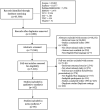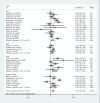Burden of metabolic syndrome in the global adult HIV-infected population: a systematic review and meta-analysis
- PMID: 39342258
- PMCID: PMC11438355
- DOI: 10.1186/s12889-024-20118-3
Burden of metabolic syndrome in the global adult HIV-infected population: a systematic review and meta-analysis
Abstract
Background: Metabolic syndrome (MetS) elevates the risk of heart disease and stroke. In recent decades, the escalating prevalence of MetS among people living with HIV/AIDS (PLWHA) has garnered global attention. Despite MetS development being associated with both traditional and HIV-related factors, evidence from prior studies has shown variability across geographical regions. This study aimed to conduct a systematic review and meta-analysis of MetS burdens in adult PLWHA at the regional and global levels, focusing on the common effect size of HIV infection and antiretroviral therapy (ART) on MetS.
Methods: This review followed the PRISMA 2020 guidelines. A comprehensive search and review of original articles related to MetS and HIV published in peer-reviewed journals between January 2000 and December 2023 were conducted. A random effects model was used to calculate the pooled prevalence/incidence of MetS and the common effect size of HIV infection and ART exposure on MetS.
Results: A total of 102 studies from five continents comprising 78,700 HIV-infected participants were included. The overall pooled prevalence of MetS was 25.3%, 25.6% for PLWHA on ART, and 18.5% for those not receiving treatment. The pooled incidence of MetS, calculated from five studies, was 9.19 per 100 person-years. The highest pooled prevalence of MetS was observed in the Americas (30.4%), followed by the Southeast Asia/Western Pacific regions (26.7%). HIV-infected individuals had 1.6 times greater odds of having MetS than non-HIV-infected individuals did (pooled OR = 1.604; 95% CI 1.154-2.230), and ART exposure had 1.5 times greater odds of having MetS than nontreatment had (pooled OR = 1.504; 95% CI 1.217-1.859).
Conclusions: HIV infection and ART exposure contribute significantly to the increased burden of MetS. Regions with a high burden of HIV and MetS should prioritize awareness and integrated care plans for major noncommunicable diseases (NCDs), such as heart disease and stroke. The implementation of integrated care for HIV/AIDS patients and NCDs is essential for addressing the high burden of multimorbidity in PLWHA.
Registration number: INPLASY202290018.
Keywords: Antiretroviral therapy; Global adult HIV-infected population; HIV infection; Metabolic syndrome; People living with HIV/AIDS.
© 2024. The Author(s).
Conflict of interest statement
The authors declare no competing interests.
Figures




References
-
- Antiretroviral T. Guideline on when to start antiretroviral therapy and on pre-exposure prophylaxis for HIV. 2015. - PubMed
-
- Haridas RS, Shelke SA, Deshmukh A. Study of metabolic syndrome, diabetes, and cardiovascular risk in patients with HIV at a tertiary hospital. J Cardiovasc Disease Res. 2022;13:2911–7.
Publication types
MeSH terms
LinkOut - more resources
Full Text Sources
Medical

